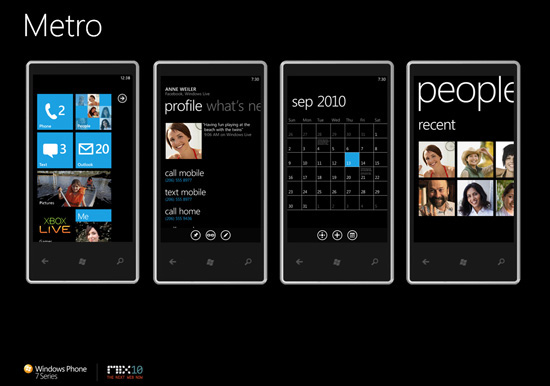Intel Unveils Moorestown and the Atom Z600, The Fastest Smartphone Platform?
by Anand Lal Shimpi on May 4, 2010 11:54 PM EST- Posted in
- Smartphones
- Intel
- Atom
- Mobile
- SoCs
Intel Takes a Stand: No Windows Phone 7 Support
Apparently someone at Microsoft must’ve peed in Intel’s cheerios because Moorestown won’t be found in any Windows Phone 7 devices. According to Intel it’s more than just a spat over breakfast, Intel claims that Windows Phone 7 is still optimized for very low end ARM SoCs. Intel went on to say that despite the advances in the OS, Windows Phone 7 isn’t progressing fast enough from an architecture standpoint and that it is an “old OS with many of the warts we’re trying to get away from”. Apparently Windows Phone 8 falls into the same category and it too will not be supported by Moorestown.

Windows Phone 7, Not Supported by Moorestown
The same goes for Symbian (obviously).
Intel says that these OSes aren’t on a steep enough roadmap to make the Moorestown investment. It’s difficult to say whether or not Intel is right, we’ll have to wait to see how Windows Phone 7 scales with performance once the first devices hit later this year.










67 Comments
View All Comments
DanNeely - Wednesday, May 5, 2010 - link
I think you're misunderstanding the slide. It's not saying 1024x600 to 1366x768, it's saying upto 1366x768 on interface A, upto 1024x600 on interface B.Mike1111 - Wednesday, May 5, 2010 - link
Thanks for the clarification. Looks like I really misunderstood this sentence:"Lincroft only supports two display interfaces: 1024 x 600 over MIPI (lower power display interface) or 1366 x 768 over LVDS (for tablets/smartbooks/netbooks)."
uibo - Wednesday, May 5, 2010 - link
I wonder how many transistors are there in a Cortex A9 core? Just the core nothing else.For me it seems that ARM could just double or quadruple their core count against the Intel solution while still maintaining lower transistor count.
Also they could just increase the CPU clock speed, if there is a market for the more power-hungry Intel solution the there is one for the ARM also.
strikeback03 - Wednesday, May 5, 2010 - link
I would imagine even less smartphone software is written for multi-core now than was for desktop when dual-core CPUs started appearing in desktops. So going beyond 2 cores at this time is probably not a great move. Plus the dual core A9 isn't out to see power consumption yet, but even at 45nm I doubt it will be much below the current 65nm single-core chips if at all, so if Intel is already competitive then ARM doesn't exactly have the power budget to add cores.uibo - Thursday, May 6, 2010 - link
That actually makes sense. Nobody is going to write multi-threaded apps for a single thread CPU. I'd imagine that the number of apps, which experience is hindered by performance, is not that great at the moment. Games, browsers, UI, database for the info stored in your device - I'm not expecting these to scale perfectly across many cores but do expect a x0% performance increase.DanNeely - Thursday, May 6, 2010 - link
The real benefit for the 2nd core is probably multi-tasking. Your streaming music app can run in the background on the second core while your browser still has a full core to render web pages.Shadowmaster625 - Wednesday, May 5, 2010 - link
Mooresetown has to support a desktop OS. Intel is clearly moving towards wireless computing. They are bringing wireless video. With wireless video you can turn your phone into a desktop pc instantly by adding a wireless monitor and keyboard. What is the point of moving in that direction if you're moving towards a crippled OS? (Not that windows isnt crippled, if you consider obesity a form of cripple.)If it needs a pci bus, then emulate one!
Caddish - Wednesday, May 5, 2010 - link
Just registered to say keep up the good work. Since the SSD antology I have red all of your article like that one and they are awesomelegoman666 - Wednesday, May 5, 2010 - link
Excellent article, very well written.jasperjones - Wednesday, May 5, 2010 - link
Anand,You mention twice in the article that Apple and Google dominate the smartphone market. This is utter nonsense. The numbers from IDC as well as the numbers from Canalys clearly show that Nokia is the worldwide leader in the smartphone market. RIM is number 2. Apple is in the third place, the first company that produces Android devices, HTC, has the number 4 spot.
I realize that Nokia's market share in the U.S. is smaller than its global market share. However, even if we restrict ourselves to the U.S. market, RIM smartphone sales are bigger than those of Apple. They are also bigger than the sales of all Android smartphones combined.